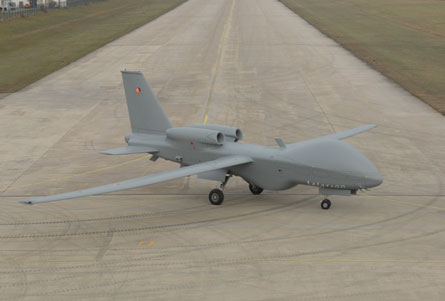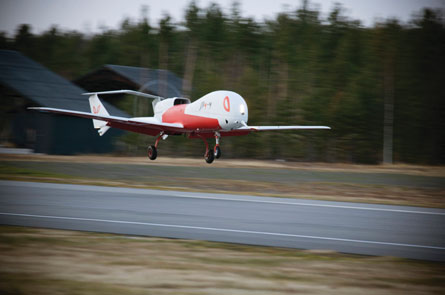Next week's AUVSI North America exhibition in Denver, Colorado should provide an opportunity for a variety of European medium-altitude, long-endurance (MALE) unmanned systems to strut their stuff in what has largely shaped up to be a US-centric market, especially if the showing at the Farnborough air show in July is any sign of what is in store.
Europe has ample home-grown options for unmanned air vehicles, most of them marketable to international customers, but some of the programmes continue to suffer from lack of government funding while others plod forward on self-financed schedules.
For example, EADS plans to continue funding the Talarion UAV - for now - while waiting for Germany, Spain and possibly the UK, to rally support and commit defence spending on the aircraft, which was unveiled last year.
 |
|---|
© EADSEADS continues to fund Talarion but needs more support to get the project up to speed |
EADS said in January that it could not continue to self-fund the project beyond the middle of 2010 without a combined €1.5 billion ($1.95 billion) commitment from the participating countries. Stefan Zoller, who leads EADS's defence division, said at the time that Talarion would help Europe bolster its presence in the global UAV market. At Farnborough, Zoller adjusted the calendar, saying that EADS could hold on through autumn, when European governments are expected to make known their defence spending priorities.
The future of the Talarion partnership is murky. Last year, Germany chose Israeli UAVs for deployment in Afghan airspace, over home-grown European or even US systems. French defence minister Herve Morin said in June that his government is talking to the USA about possibly purchasing the Predator B system from General Atomics to fill its MALE needs.
EADS's troubles in getting Talarion off the ground have not dissuaded newcomers to the MALE market.
Absent from AUVSI but not from the growing European MALE field is Alenia Aeronautica, which recently announced an ambitious new self-financed developmental UAV programme and has completed another round of flight testing on the Sky-Y platform.
The Italian company has set itself a two-year deadline to develop and deliver to potential customers a new 1,800kg (3,960lb) maximum take-off weight MALE aircraft based in part on technologies proven in the Sky-Y programme. The will have a 15h maximum endurance and multi-sensor payload, together with an interoperable tactical control station - all completely developed in Italy using Finmeccanica companies' technology and expertise.
Carlo Logli, Alenia's senior vice-president of special airborne systems, is confident the company can stick to the challenging schedule it has imposed and offer its new MALE system on the international market at a competitive price, free from export restrictions.
Alenia spent most of July flight testing its Sky-Y technology demonstrator UAV, the fourth phase of testing for the aircraft since its initial 2006 roll-out. The tests were to check out an experimental flight-control system developed in collaboration with its Alenia SIA subsidiary as well as the integration of a Selex Communications wideband datalink that enables the aircraft to make video, image, data or voice transmissions to a ground control station up to 110nm (200km) away and at a rate of up to 45Mb/s, Alenia says.
 |
|---|
© Alenia AeronauticaAlenia's proven Sky-Y programme could be the basis for a new UAV programme |
Industry analysts say that while some chief executives may say they are optimistic about the autumn, this will be a difficult year to move programmes out of self-funding or development and into their own budget lines. Even in what seems to be the ever-growing unmanned market, times are tough, says Phil Finnegan, a defence industry analyst with the Virginia-based Teal Group.
"There's just going to be tremendous pressure," he says "So for any project that's still in development, they are definitely at risk."
Urgent operational requirements will continue to keep the overall UAV market afloat, he says, with many countries continuing to give intelligence gathering and support a high budgetary priority even in tight times. But what will ultimately hurt the MALE market, he says, is the trend of European and US allies turning to fee-for-service contracts rather than buying unmanned systems outright, such as with the Elbit Hermes 450 in UK and the Israel Aerospace Industries Heron for Germany.
 |
|---|
© Israel Aerospace IndustriesGermany ignored Europe and turned to Israel's Heron for its Afghan UAV deployment |
"I think you'll see the growth slowing down, this year, in some ways, definitely," Finnegan says. "But at the same time, in many European countries, the adoption of UAVs is still relatively low and the demand for intelligence out of that 10,000-30,000ft [3,000-9,150m] range remains high, so that's going to continue to buoy the market. I don't see the bottom falling out of the market, even if there's a withdrawal from Iraq and Afghanistan, partly because you're going to need surveillance in those areas even after combat troops withdraw."
Source: Flight International























